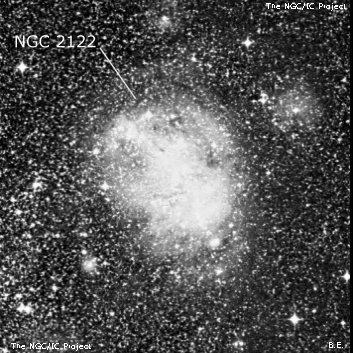
Open cluster S-L 740 is 10' SSE and S-L 769 is 23' due east. At 394x; S-L 769 appeared large, round, smooth moderate surface brightness, nearly 1' diameter. A mag 13 star is attached at the east end.
James Dunlop discovered NGC 2122 = D 106 on 3 Aug 1826 with his 9" reflector and recorded "A faint elliptical nebula, about 2' diameter; slightly condensed to the centre." He made 2 observations and his position is just 3' NE of center.
JH observed this cluster/nebula on 5 sweeps (h1319). On his first observation from 24 Nov 1834 he logged "B, L nebula, 6' l, 5' br; resolved, in part; chief star 11th mag taken." On a second sweep he called it "pB, L, irregularly round, glbM, 3', resolved into stars 15th mag." On his 4th sweep he noted "cluster, irregular figure, consists of 3 or 4 disjoined clusters, the middle one the largest and brightest; of 3 or 4 large stars and nebulosity; chief star taken."
600/800mm - 30" (10/13/15 - OzSky): Superb HII region and cluster! Unfiltered, at least 3 dozen stars are resolved in a 4' region including several fairly bright mag 12 stars. The brightest mag 12.2 star HD 270145 at the center is a supermassive O6-class (binary). The NPB filter provided an excellent contrast gain at 152x! With the filter, the nebulosity (N180B) was very bright and large, round, ~4.5' diameter, brighter on the southwest end and overall displayed an irregular surface brightness with some darker areas. A bright, small detached knot (N180A), just south of 3 stars, is just off the southwest side [~2.5' from center]. NGC 2122 is part of association LH 117 and contains several early O-type stars..
Notes by Steve Gottlieb